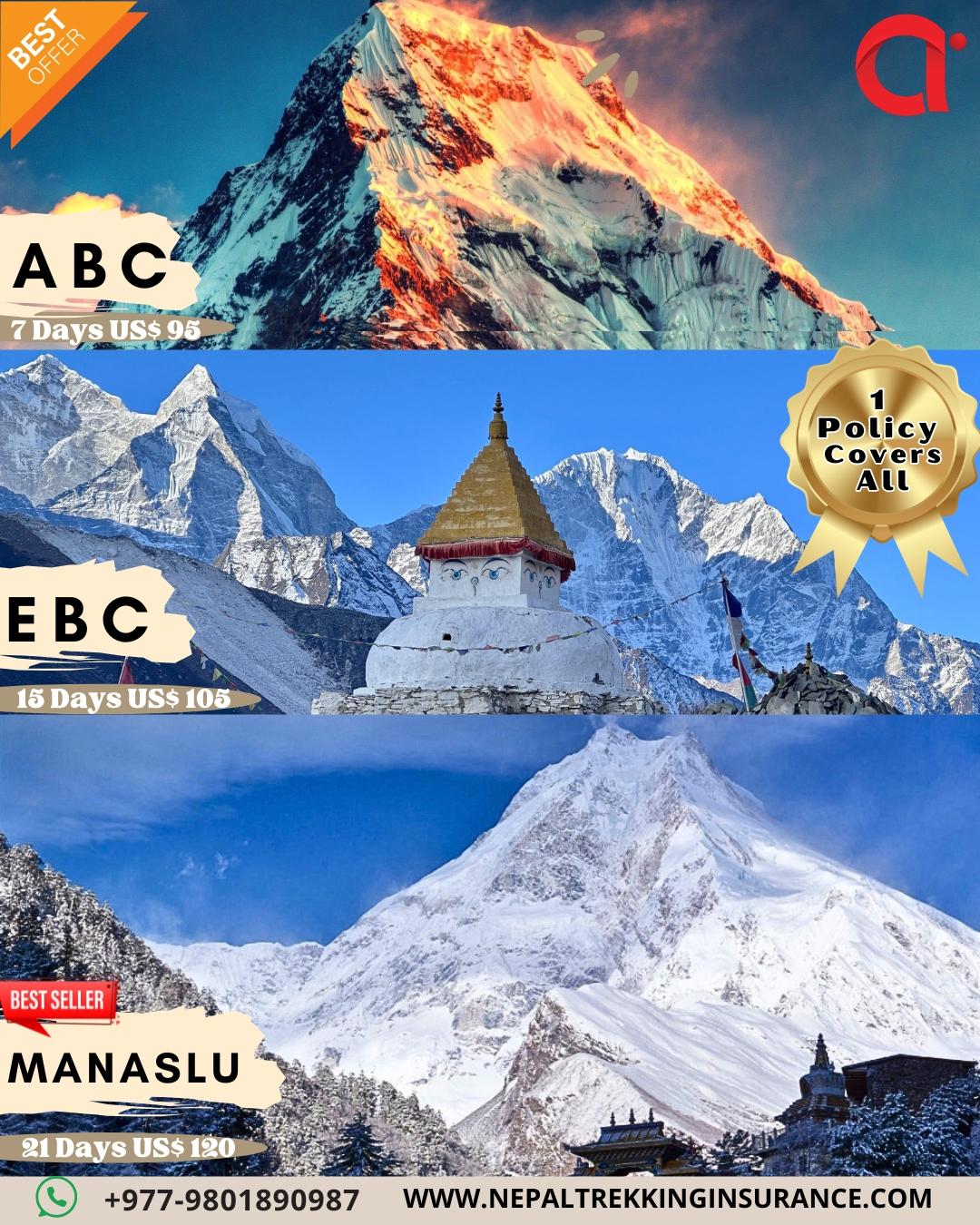
Introduction to Nepal Trekking Insurance
Trekking in Nepal offers adventure seekers some of the most breathtaking landscapes and challenging routes on the planet. From the iconic Everest Base Camp to the less-traveled Manaslu Circuit, the allure of the Himalayas is palpable. However, trekking at high altitudes, especially up to 5,500 meters, comes with its own set of risks. This is where Nepal trekking insurance becomes an essential part of your adventure plans.
Proper trekking insurance is not just a precaution; it's a necessity for anyone taking on the rugged terrain of Nepal. High-altitude trekking carries the risk of altitude sickness, injuries, and unpredictable weather conditions, all of which can lead to unforeseen medical emergencies. Additionally, the remote nature of these trails means that rescue operations can be complex and costly. Having Comprehensive Nepal Trekking Insurance ensures you are financially protected and have access to essential services like helicopter evacuations if needed.
When selecting travel insurance for trekking in Nepal, it's crucial to ensure that your policy covers medical emergencies at altitudes up to 5,500 meters. Not all standard travel insurances provide this level of high-altitude coverage, making it important to choose a plan designed specifically for mountaineering and trekking adventures.
Aside from medical coverage, good trekking insurance also protects against trip cancellations, interruptions, and personal losses such as theft of gear or travel documents. This complete protection allows you to focus on the thrill of your ascent without worrying about potential setbacks.
Choosing the right trekking insurance can make or break your Nepal adventure. Make sure it covers everything from medical emergencies to high-altitude evacuations, ensuring peace of mind during your journey through the Himalayas.
-
Essential Coverage for Medical Emergencies
When trekking up to 5,500 meters in Nepal, having comprehensive medical emergency coverage is vital. Mountainous regions come with their own set of risks, including altitude sickness, frostbite, and hydration issues. Medical emergencies can escalate quickly, making it essential to have an insurance policy that caters specifically to these high-altitude challenges.
Firstly, ensure that your policy covers medical evacuation. In remote areas, getting to a hospital could require a helicopter, which is expensive. Your insurance should cover these costs so you receive urgent medical attention without worrying about the fees.
Next, verify that your coverage includes treatment for altitude sickness, which can become a significant issue above 3000 meters. Even if you're seasoned, altitude sickness can strike unexpectedly, making it crucial to have access to necessary medical care.
Additionally, check if the insurance covers hospitalization expenses. Should you require extended medical attention, hospital bills can quickly add up. Comprehensive coverage will provide peace of mind, ensuring you receive the care you need without financial stress.
Another critical factor is 24/7 emergency assistance. Your provider should offer round-the-clock support, helping you navigate medical facilities, coordinate evacuations, and receive treatments promptly.
In summary, for a successful and safe trekking experience up to 5,500 meters in Nepal, your travel insurance must cover medical evacuations, altitude sickness treatments, hospital expenses, and offer 24/7 emergency assistance. This comprehensive approach will protect you against unpredictable medical emergencies, allowing you to focus on the breathtaking trek ahead.
Adventure Activities and High-Altitude Coverage
When planning a trek up to 5500 meters in Nepal, it’s crucial to have travel insurance that includes coverage for adventure activities and high-altitude trekking. Not all insurance policies cater to high-altitude adventures, so it's vital to check the specific terms and conditions of your plan.
Look for an insurance policy that explicitly mentions coverage for "high-altitude trekking" or "mountaineering." Ensure the policy covers altitudes above 4,000 meters, as many policies cap coverage at this level. This guarantees you are protected in case of altitude-related sickness or accidents during your trek.
Furthermore, your insurance should cover adventure activities like rock climbing, rappelling, and traversing risky terrains. These activities can sometimes be excluded in standard travel policies, so a specialized adventure travel insurance becomes necessary. Coverage for high-altitude escapes and emergency evacuations via helicopter is also critical due to the remoteness and inaccessibility of high-altitude locations in Nepal.
Not having the right coverage can leave you vulnerable to high costs and severe complications if an accident occurs. Imagine trekking near Everest Base Camp, where medical facilities are limited and evacuations are expensive. The right insurance ensures you receive prompt medical attention and evacuation without financial worry.
When choosing insurance, read reviews and consult with fellow trekkers or travel forums to identify reputable providers. Remember, paying slightly more for comprehensive coverage is a worthwhile investment for your safety and peace of mind. Reliable insurance affords you the confidence to fully embrace the adventure of trekking through Nepal’s majestic landscapes
Trip Cancellations and Interruptions
When trekking in Nepal, particularly up to altitudes of 5,500 meters, the unpredictability of weather and other unforeseen events can derail even the best-laid plans. Therefore, having insurance that covers trip cancellations and interruptions is crucial. This kind of coverage ensures you are financially protected if your trek gets canceled or disrupted due to circumstances beyond your control.
First and foremost, look for policies that cover cancellations due to sudden illness, severe weather conditions, or natural disasters like earthquakes and landslides. These are common occurrences in the rugged terrains of Nepal, and being stuck without coverage can be both dangerous and costly. Check if the policy reimburses non-refundable costs like flights, accommodations, and trekking permits, as these can add up quickly.
Interruption coverage is just as important. Imagine you’re halfway through your trek and an emergency back home forces you to abandon your trip. Interruption insurance will reimburse you for any pre-paid, unused portions of your trip and potentially cover the extra travel expenses incurred to return home early.
It's also smart to consider the policy’s emergency evacuation clauses, especially when trekking at high altitudes. In the event that your journey is interrupted due to altitude sickness, avalanches, or other emergencies, knowing that evacuation costs are covered can offer immense peace of mind.
The key to choosing the right trip cancellation and interruption insurance for trekking in Nepal is to thoroughly read the terms and conditions. Make sure the policy explicitly covers high-altitude trekking and your specific needs. Financial protection can make all the difference in transforming an interrupted adventure into a manageable, less stressful situation.
Theft, Loss, and Evacuation Protection
Trekking in Nepal offers an unparalleled adventure, but it's essential to prepare for unforeseen challenges like theft, loss, or the need for emergency evacuation. A robust travel insurance policy specifically designed for trekkers can provide valuable peace of mind.
First, let's talk about theft and loss. High-altitude treks often take you through remote areas with limited security, making your belongings more vulnerable. An insurance policy that covers personal property can reimburse you for lost, stolen, or damaged gear. Look for coverage that includes items like your trekking gear, electronics, and important documents. It's wise to document your belongings before the trip to make any potential claims process smooth.
Emergency evacuation is another critical aspect to consider. Trekking to altitudes up to 5,500 meters involves navigating challenging terrains where medical facilities are scarce. An abrupt health issue or severe injury might require immediate evacuation to a lower altitude or a medical facility. Ensure your policy covers helicopter evacuations, which are often the quickest and safest way to get out of harm’s way in the Himalayan regions.
Additionally, many policies offer 24/7 emergency assistance, ensuring that help is just a call away, regardless of the time zone differences. This can be a lifesaver if you find yourself in a perilous situation miles away from the nearest city.
When selecting your insurance, read the fine print and understand what constitutes valid claims for theft, loss, and evacuation. This diligence ensures that you’re adequately protected, allowing you to focus fully on enjoying the breathtaking landscapes and cultural richness of Nepal. Prioritize insurance plans that offer comprehensive coverage and support for the unique challenges posed by high-altitude trekking.
Choosing a Reputable Insurance Provider
Selecting the right insurance provider for your high-altitude trekking adventure in Nepal is crucial. Not all travel insurance policies are created equal, particularly when it comes to covering activities like trekking up to 5,500 meters. Here’s how you can make an informed choice.
First, research companies that specialize in adventure travel insurance. Providers like World Nomads, IMG Global, and CSA Travel Protection are well-regarded in this niche. Look for insurers with strong reputations and positive reviews from trekkers who have undertaken similar trips.
Next, scrutinize the policy details. Ensure the insurance explicitly covers high-altitude trekking, up to the elevations you will be reaching. Some insurers have exclusions for activities above certain altitudes, so this is a crucial check. Moreover, high-altitude coverage often includes specific medical evacuation provisions, helicopter rescues, and care in remote areas, which can be lifesaving in case of emergencies.
Consider the provider’s customer service quality. Reviews and testimonials can provide insights into how responsive and helpful the company is, especially during a crisis. Favor companies with 24/7 emergency support and easy claims processes to minimize hassle if an issue arises.
Lastly, compare costs and coverage levels. While budget is important, the cheapest option isn't always the best. Balance the premium against the coverage it offers—making sure it addresses your needs comprehensively.
In summary, choosing a reputable insurance provider for your Nepal trekking adventure involves thorough research, careful policy examination, and a focus on specialized coverage. Make sure you’re well-protected so you can focus on enjoying the incredible experience of trekking up to 5,500 meters in Nepal.

